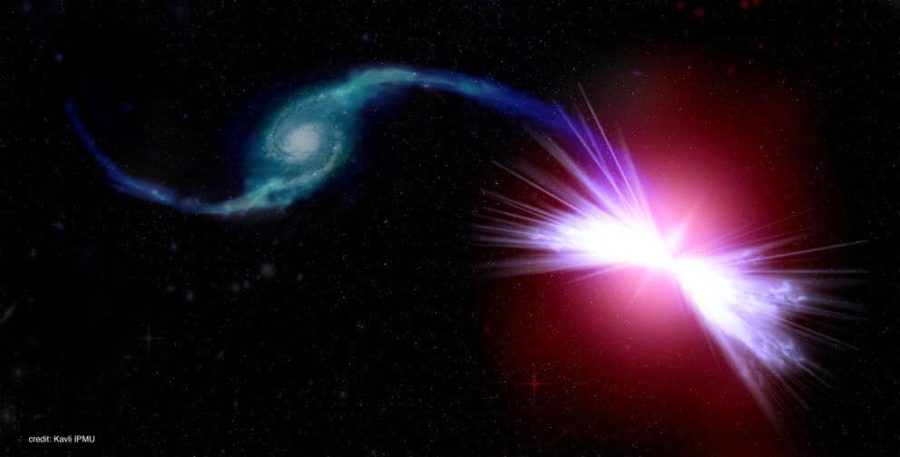Today, astronomers from the Sloan Digital Sky Survey (SDSS), including scientists at Penn State University, are announcing the discovery of a new class of galaxies called “red geysers.” These galaxies harbor supermassive black holes with winds that produce a mysterious kind of “galactic warming” that, over the last few billion years, has turned huge numbers of galaxies into deserts devoid of fresh young stars.
“Until now, the source of this warming has been a long-standing mystery in the evolution of galaxies,” said Donald Schneider, distinguished professor of Astronomy and Astrophysics at Penn State, a coauthor of the study and the SDSS’s Scientific Publications Coordinator. “We now have been able to begin solving this mystery because the innovative instrumentation of the Sloan Digital Sky Survey has allowed us to determine the detailed motions of gas in a large number of galaxies.”
For most of their lives, many galaxies, including the Milky Way, are lush environments for turning gas into stars. But it has been a mystery why some galaxies stop producing new stars. “We knew that there had to be a way to prevent star formation in these galaxies, and now we have a good idea of what it is,” said Edmond Cheung, an astronomer at the University of Tokyo’s Kavli Institute for the Physics and Mathematics of the Universe and the lead author of the study published on May 27, 2016 in the journal Nature.
The international SDSS team was studying hundreds of galaxies when its astronomers caught a supermassive black hole blasting away at the cold gas in the black hole’s galaxy. “Galaxies start out as star-making machines with a simple recipe: gas plus gravity equals stars,” said Kevin Bundy, a coauthor of the study and the principal investigator of the new SDSS campaign that led to the discovery. “Here we have a galaxy that has everything it needs to form new stars, but it is dormant. Why is that?”
Astronomers had long suspected that the reason has something to do with the supermassive black hole that is at the centers of many galaxies. But solid evidence was lacking, partly because it used to be difficult to map the internal structure and motions of gas and stars throughout a galaxy. “If we looked just at the center of the galaxy like we used to, we could have learned about the central black hole, but we would have missed the story of how it affects the rest of the galaxy,” Cheung said. “Another reason is that the wind from supermassive black holes comes and goes quickly, so catching the wind red-handed is hard.”
The secret to capturing the whole story is the SDSS’s new component survey, Mapping Nearby Galaxies at Apache Point Observatory (MaNGA). “With MaNGA’s technological upgrade to the Sloan Foundation Telescope, we can make detailed maps of galaxies ten to a hundred times faster than we could just ten years ago,” said Renbin Yan of the University of Kentucky, a coauthor of the study and MaNGA’s survey scientist. “Since MaNGA studies so many galaxies, our snapshots can reveal even the quickest changes happening in galaxies. And that’s how we found Akira.
Cheung nicknamed this premier example of a red geyser galaxy “Akira” after the famous Japanese manga comic character, an homage to both the MaNGA survey and his home institution in Japan. Akira has a companion galaxy that Cheung called “Tetsuo” for another character in the same manga. Akira is pulling gas away from Tetsuo, which fuels Akira’s supermassive black hole winds. The winds driven by Tetsuo’s gas are the reason that Akira is currently a red geyser galaxy. Bundy came up with the name “red geyser” because these wind outbursts reminded him of the sporadic eruptions of a geyser and because the failure to form new stars leaves the galaxy with only red stars.
As with global warming on Earth, galactic warming has long-term consequences for red-geyser galaxies – their gas can no longer form new stars. “You can think of these winds as super-heating the atmospheres of galaxies,” Cheung says. “As soon as any gas starts to cool, it gets blasted by this wind, like water droplets turning to steam.” The team theorizes that this phenomenon is quite common in dormant galaxies. Therefore, our own Milky Way Galaxy may not be safe from this galactic warming. Distant future generations may see our supermassive black hole turning our galaxy into a red geyser.
If our reporting has informed or inspired you, please consider making a donation. Every contribution, no matter the size, empowers us to continue delivering accurate, engaging, and trustworthy science and medical news. Independent journalism requires time, effort, and resources—your support ensures we can keep uncovering the stories that matter most to you.
Join us in making knowledge accessible and impactful. Thank you for standing with us!

